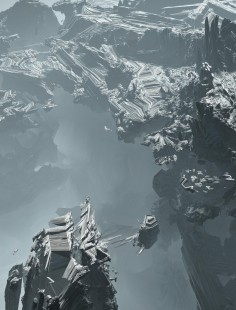Tom Beddard
ТОМ БЕДДАРД
Aurullia

source: creativeapplicationsnet
The Aurullia series are Tom Beddard‘s interpretation of a fractal formula called Mandalay, a specific type of Mandelbox with additional parameters that allow scaling of the folding on individual axes, either in parallel or one after.
Tom explains that the upside of Mandalay is that you can get an interesting mix of structures without the obvious patterns you often see in fractals. The curved domes are due to the Mandelbox like sphere folding and the towers due to the different fold scaling of individual axes.
He is also adding additional rotational changes between the images which helps create the transition from a crude unrefined state to a very geometric and architectural form, like different stages of a civilisation in the imaginary Kingdom of Aurullia – Tom.
Mandalay was first described (like all 3d fractal algorithms) on fractalforums.com.
Aurullia was created with Fractal-lab – a tool Tom Beddard has been building for the last few years that allows rendering of fractals in the browser with WebGL. More information about Fractal-lab can be found here.
.
.
.
.
.
.
.
source: subblue
Born in 1976 in London but grew up just outside Manchester.
Studied physics at Nottingham University and then moved to
Scotland to do a PhD in laser physics at the University of St Andrews.
After finishing my PhD the booming world of the dot com internet was more appealing than academia and so I became a web developer specialising in ecommerce and content management systems. For the past eleven years I have worked as a web developer for a variety of agencies in Scotland.
I currently live just outside Edinburgh and now run my own business Hyper Digital Ltd.
.
.
.
.
.
.
.
source: aolartists
Tom Beddard was born in London but grew up just outside Manchester in the UK. Although torn between the arts and science, he studied physics at Nottingham University and then moved to Scotland to do a PhD in Laser Physics at the University of St. Andrews.
After his PhD, the world of the “dot-com” internet boom was more appealing than academia, so Tom became a web developer specializing in e-commerce content management systems. For the past ten years Tom has worked at a variety of agencies in Scotland and now currently works at Glasgow based 55 Degrees, which specializes in interactive museum exhibits and video production. Tom considers himself to be a ‘creative coder,’ a techie who also has an appreciation for the aesthetics. His site, subblue.com, is where he writes programs and plugins exploring mathematical and generative graphics. Where possible, these experiments are interactive and have the source-code available for download. The exposure of his site and the Photoshop and After Effects plugins he has released have resulted in the creation of book covers, music videos, and stage visuals.

